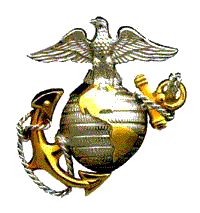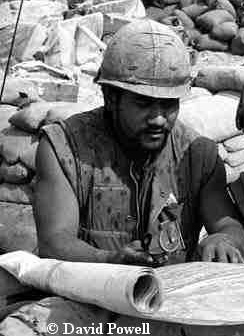
|

|
 The President of the United States takes pleasure in presenting the BRONZE STAR MEDAL to SERGEANT MAJOR MICHAEL J. NIUATOA UNITED STATES MARINE CORPS for service as set forth in the following CITATION: "For conspicuous gallantry and intrepidity in action while serving as a Fire Team Leader with Company I, Third Battalion, Twenty-Sixth Marines, Third Marine Division in connection with operations against the enemy in the Republic of Vietnam. From 1 February to 18 February 1968, Sergeant Major NIUATOA, then a Lance Corporal, was assigned to search for North Vietnamese heavy artillery positions from an exposed observation post on Hill 881 South, an outpost of the 26th Marine at Khe Sanh. He remain- ed at his post without relief during daylight hours, disregarding steady fire by snipers, mortars, rockets and artillery until, on 18 February, he spotted muzzle flashes from positions over 10,000 meters away in Laos. Under his direction, air strikes were brought to bear that resulted in the destruction of a 130mm gun battery that had been firing daily at Khe Sanh. By his steadfast devotion to duty at great personal risk, his awesome patience in discharging a diffi- cult task superbly, and his precise directions to the Forward Air Controller (Airborne), Sergeant Major NIUATOA inflicted a heavy blow to the forces besieging Khe Sanh and substantially reduced Marine casualties at Khe Sanh Combat Base. By his courage, re- solve and inspiring example under fire, Sergeant Major NIUATOA upheld the highest traditions of the Marine Corps and the United States Naval Service. FOR THE PRESIDENT, /s/ (Unknown) LIEUTENANT GENERAL, U. S. MARINE CORPS
|

Epilogue
Sergeant Major Niuatoa was recommended for an award shortly after the action described. I believe it was the Silver Star, but am not certain. Communications between 881S and Khe Sanh Combat Base (KSCB) for matters of this nature was by courier, which meant a lightly wounded Marine going down to the base for medical treatment. But if there were other more seriously wounded Marines medevaced at the same time, which there usually were, the bird would not stop at KSCB, but rather take the wounded directly to Dong Ha or the hospital ship offshore. The result was that award recommendations would have to wend their way back up to KSCB, and often didn't make it. Since there was little feedback to hill from the base about award recommendations, we wouldn't know whether the award was approved, or even if it had been received.
About 1995, I made contact with Sergeant Major Niuatoa through a mutual friend and learned that he had received no award. About a year later, a rider to the Defense Authorization Bill opened a one-year window for resubmission of Vietnam War heroic awards. I resubmitted the award at that time and it was approved for a Bronze Star w/combat "V" in time to be presented to him on the occasion of his retirement as Sergeant Major, 3d Marine Aircraft Wing, Fleet Marine Force Pacific.
The distance from 881S to the target was at least 12,000 meters, and we had no weapons on either the hill or down at the base (7,000 meters further away) that could mark for the FAC(A) or CAS aircraft. The FAC(A) tried using his marking rockets, but we could not see them at that distance. He had several flights of CAS available by this time and more were standing by if needed, since an NVA artillery battery was a lucrative and exciting target. The FAC(A) (call sign "Southern Oscar" - Capt. Tom O'Toole, USMC) proposed using CAS flights to mark for adjustments, since a couple of his "first-in" flights were about to go "bingo" fuel anyway.
He dropped the first bombs on a prominent ridge line and asked then-LCpl. Niuatoa to adjust. I suspect that Niuatoa's reply ranks among the boldest adjustments in the history of the Marine Corps, to wit; "Left a click (kilometer), add two ridge lines!" After about two more drops, Capt. O'Toole reported, in great excitement, that the last drop had blown what looked like a large bamboo mat away from the mouth of a cave, and that he could see a gun muzzle sticking out. CAS destroyed the gun, and over the next two hours, not under LCpl. Niuatoa's control, he reported working back and forth along the gun-target line between the site and Khe Sanh and destroying at least three more guns. They had to be 130mm guns since they were at least 18,000 meters, and perhaps as much as 25,000 meters west of KSCB, and the 130mm Russian field gun, with a max. range of 27,000 meters, was the only piece they had that could range that far.
Capt. O'Toole and I served together as advisors on a later tour in Vietnam, and he told me that it appeared to him that they had emplaced the guns not in battery position, but singly about 500 meters apart along the gun-target line. That way, the battery did not risk destruction by a single B-52 strike. Firing at KSCB was not a problem, because, having lined them up on the gun-target line, the NVA had only to crank in a standard range adjustment from the base gun for each of the others to fire them as a battery. They fired from that area throughout the siege, although at considerably less volume after Niuatoa found them, and I observed them fire again from the same area in 1971, during Lam Son 719. It was a good position, close to the Ho Chi Minh Trail for resupply and far enough into Laos to be at no risk from U. S. infantry forces.
The NVA traded flexibility for vulnerability. Since the base wasn't moving, they could fire at it at will using constant adjustments for each gun while keeping them relatively safe from the B-52s. However, when the siege ended and Marine units began to maneuver off the hills and outside the base perimeter, they could not bring the guns to bear. To fire on a target off the gun-target line required adjusting each gun individually, and they had neither the forward observers nor the communications for that. The result was that maneuvering units were not attacked by heavy artillery, but rather by mortars, which had to be much closer and were therefore more difficult to resupply and far more vulnerable to discovery and destruction. Had they been able to use those heavy guns against units maneuvering in the open away from their bunkers and trenches, the results could have been catastrophic for both the 26th Marines and the 1st Air Cavalry Division when it came up to the Khe Sanh plateau.
Submitted by:
William H. "Bill" Dabney, Colonel,
USMC(Ret)
Back Browser or Home
x